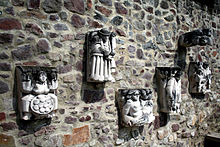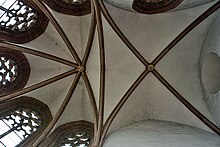Magdalenenkapelle (Magdeburg)
The Magdalene Chapel is one of the Holy Mary Magdalene consecrated chapel in Magdeburg 's Old Town .
architecture
The Gothic chapel is made of rubble stones. Sandstone blocks were used on the building edges . The church consists of a square yoke with a 5/8 polygon . The building has no buttresses , the construction is supported by thick outer walls and a barrel vault in the lower church . To the left of the entrance to the west is a small stair tower. It is believed that this originally provided access to the chapel from the monastery garden of the neighboring Mariae Magdalenae monastery .
The interior of the chapel is characterized by five high tracery windows and a ribbed vault . The current Gothic roof shape was only rebuilt in the 1960s when the war damage caused by World War II was removed.
history
The foundation stone was laid in 1315. The construction of this Corpus Christi chapel served to atone for a host that was thrown away at this point and thus desecrated . In 1385 the patronage of the chapel was given by Pope Urban VI. transferred to the directly neighboring monastery Mariae Magdalenae, where the name Magdalenenkapelle comes from.
When the imperial troops stormed Magdeburg during the Thirty Years' War on May 10, 1631, the chapel was also badly damaged. Reconstruction only began in 1711. The chapel received a mansard roof with a turret . The new consecration took place on August 5, 1715.
In the years 1846/1847 the chapel was restored and the ribbed vault was added. The neighboring Magdalenenkloster, which had not been used as a monastery since the 16th century , was demolished in 1848. In 1857 the tower of the chapel was renovated and an organ gallery was installed .
Another restoration took place between 1929 and 1930, during which the chapel was painted by the Magdeburg painter Johannes Sass .
The severe destruction of Magdeburg during the Second World War also affected the Magdalenenkapelle, the roof of which was completely destroyed. The chapel vault, however, remained intact.
In 1966 the chapel was rebuilt. It received a steep gable roof and this time a pointed roof turret. This resumed the original Gothic roof design that had been abandoned in the 18th century .
In 1968 the chapel was made available again for a religious purpose. The city of Magdeburg remained the owner of the building, but it was used by the Evangelical Lutheran (old Lutheran) church . This had co-financed the reconstruction and therefore received the chapel free of charge for 30 years.
However, there were soon problems with the fabric of the building. As early as 1972, the underfloor and wall heating was damaged by rising damp. The continually worsening condition caused the Old Lutheran congregation to leave the chapel in 1984.
Another restoration took place. In 1988 the chapel was opened to the public again as a memorial to the French Lazare Carnot , who had died in Magdeburg . However, this form of use only lasted until 1989. It was closed again. In 1991 the chapel was handed over to the Catholic aid organization Subsidaris , which still uses the chapel today.
It is planned to build a new Premonstratensian monastery next to the chapel . Together with the university and future monastery church of Sankt Petri , the parish hall and the Magdalenenkapelle, this is to form a comprehensive atrium complex.
Tell about the foundation of the Magdalenenkapelle
According to legend, the neighboring Pauline monastery was broken into. In search of valuables, the thief took a box of host, not knowing that there were sacred hosts in the container. When he discovered the monstrousness of his deed at home, the perpetrator, remorseful, wanted to put the container on the altar of St. Peter's Church the next day . However, for fear of discovery, he did not dare to do so, and walked past the church over a bridge that spanned the ravine between the church and the Magdalenenkloster in the direction of the Bone Hauerufer . There he poured the hosts into a corner. He then went unnoticed to the dressing yard and is said to have sold the empty host box to a Jewish trader. He was arrested in the process. Meanwhile, the horses of a servant who brought Elbe water to the brewery shied away in the Bone Tusk Bank. The horses refused to go on. This is how one should have become aware of the hosts. The servant and a wealthy miller who carried the hosts on the tip of his sword delivered the find. The confessed thief was sentenced to death by the jury for the iniquity of the holy hosts . As atonement for the sacrilege, the Magdeburg citizens decided to build a chapel on the site of the host found, which was later called the Magdalenenkapelle.
literature
- Hans-Joachim Krenzke: Churches and monasteries in Magdeburg. Magdeburg - Office for Public Relations and Protocol, Magdeburg 2000 ( State Capital Magdeburg 71, ZDB -ID 1222115-6 ).
- Sabine Ullrich: Magdeburg - architecture and urban development. Stekovics, Halle / Saale 2001, ISBN 3-929330-33-4 .
Coordinates: 52 ° 7 '58.9 " N , 11 ° 38' 42.8" E






